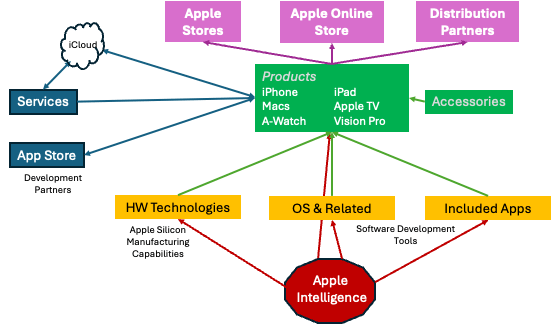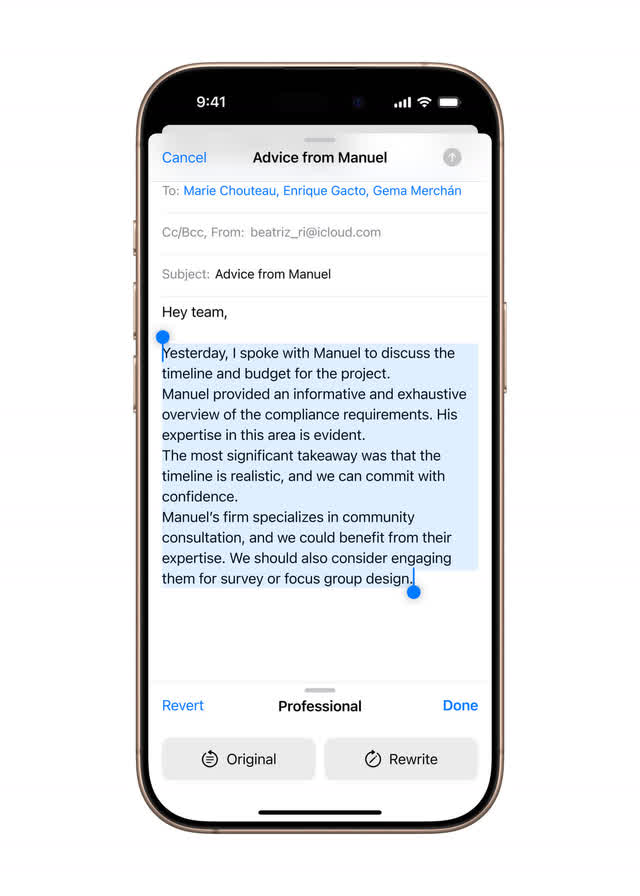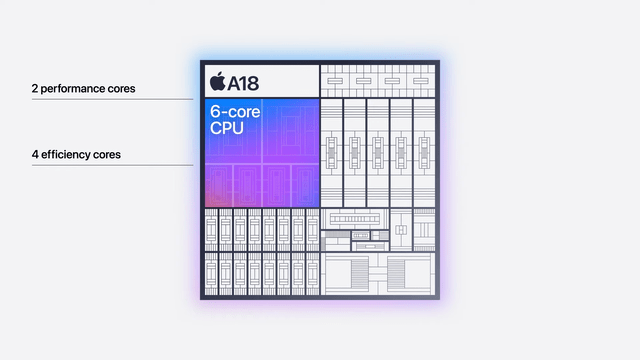Summary:
- Apple unveiled its newest iPhone and expanded Apple Intelligence, solidifying its competitive edge and leveraging its robust product and technology platform.
- It is unleashing amazing new capabilities on the iPhone 16 with Apple Intelligence.
- Apple’s on-device generative AI capability is a unique competitive advantage powered by Apple Silicon.
- The new capabilities enabled by Apple Intelligence are not backward compatible with older iPhones (other than the 15 Pro), which could drive an upgrade super-cycle.
DutcherAerials/iStock Unreleased via Getty Images
Yesterday, Apple (NASDAQ:AAPL) (NEOE:AAPL:CA) unveiled its latest iPhone and expanded on its Apple Intelligence roadmap. This showcased the company’s incredible product and technology platform strategy, solidified its competitive advantages, and ignited a powerful new source of growth.
Apple introduced many new features to its iPhone yesterday, but to understand its strategy and real profound value, you need to focus on its comprehensive product and technology platform strategy. Since I first promoted the strategic and high-growth value of a platform strategy in my 1995 book, Product Strategy for High-Technology Companies, many companies, including Amazon, Nvidia, and Apple, have leveraged this strategic approach to enormous success.
Apple’s introduction of its iPhone 16, built from the ground up for Apple Intelligence, and its roadmap for deploying Apple Intelligence across all of its products are among the best-ever examples of the advantages of a platform strategy.
Apple’s Product/Technology Platform
Here is a quick review of Apple’s product and technology platform.
The fundamental building blocks of Apple’s platform are its hardware technologies, operating system and related, and its included apps. These all are combined to create its primary products, including many of the same hardware and software elements.
These are complemented by Apple’s App Store and broad service offerings, which generate significant revenue for Apple. The Apple iCloud connects all of these services. The wider platform also includes its broad distribution network of Apple Stores, online ordering, and strong distribution partners.
Apple’s Product and Technology Platform with Apple Intelligence (Author)
Now, Apple is greatly enhancing the capabilities of its entire platform, including operating systems, its own apps, and independent apps with Apple Intelligence.
Apple Intelligence
Apple Intelligence is a set of machine learning, artificial intelligence, and generative AI technologies broadly applied across Apple’s entire platform of products, applications, and operating systems. This enables new capabilities previously not possible. The possibilities are vast, but here are some that Apple plans to release soon:
- With intelligent writing tools, it can automatically rewrite emails, documents, notes, messages, etc.
- It can automatically summarize lectures, long discussion threads, and written documents.
- It can prioritize emails, messages, and notifications based on what it learns about your preferences.
- It can transform Siri into a generative AI engine with the advantage of knowing the context and keeping information stored on your phone.
- In addition, Siri can either respond on the device or integrate with ChatGPT on Apple’s private, secure cloud.
- It can transform the iPhone camera into a window on the world as direct and immediate input into generative AI to provide explanations, interpretation, and helpful links.
- It can rapidly search your photo library using intelligent image recognition to find photos based on the generalized criteria you provide.
- It can put together custom photo videos based on any preference you provide.
- It can enable app developers to incorporate Apple Intelligence into their apps.
In truth, Apple Intelligence’s possibilities across all its products are unlimited. New capabilities will be coming for many years.
Apple’s unique strategy is that it can use your iPhone as a generative intelligence device rather than send all requests to servers like Gemini, Claude, or ChatGPT. This preserves confidentiality and can incorporate unique information on your phone. And this all starts with the new iPhone 16.
iPhone 16
The most important aspect of the new iPhone 16 is that it was built from the ground up for Apple Intelligence. This starts with an advanced chipset explicitly designed for Apple Intelligence’s processing needs.
The iPhone 16 incorporates the new A18 chipset designed with TSMC’s second-generation 3-nanometer technology. It includes a 6-core CPU with two performance cores, four efficiency cores, and a 16-core neural engine. The neural engine will power Apple Intelligence and machine learning. There is also a 5-core GPU that supports hardware-accelerated ray tracing. It has a higher memory bandwidth to support Apple Intelligence and will likely include more RAM.
The iPhone 16 Pro utilizes an even more powerful A18 Pro chipset, enabling that device version to do even more. All of this requires more power, so even though these chip sets are more energy efficient, Apple has increased the battery size in the iPhone 16 while still reducing the overall device size and weight.
This means that the iPhone 16 will be able to incorporate generative AI capabilities directly on the device, which is good news for users.
iPhone 16 Rewrite Example (Apple)
This illustrates the comprehensive power of Apple’s platform: applications that can apply generative AI, a device to process the applications, and, most importantly, the advanced Apple Silicon technology to power the device.
New Apple Watch Series 10 and AirPods
Apple also introduced the new Series 10 Apple Watch and new AirPods. In addition to many new designs and features, they also apply machine learning technology. The Apple Watch Series 10 uses ML to add translation capabilities and tests for sleep apnea. The AirPods use it to provide adaptive audio tailored to the environment, personalized spatial audio, and a new combination of hearing tests and hearing aids. My orders are already in.
To do this, the Apple Watch Series 10 has additional computing power with a new S10 SiP with a 64‑bit dual-core processor, a 4‑core Neural Engine, and a 64GB capacity. The AirPods use the new H2 chipset.
Implications for Investors
The new iPhone 16 and Apple Intelligence leverage Apple’s already powerful product and technology platform, introducing several new critical considerations for investors.
- These on-device generative AI capabilities are only available from Apple, and with its Apple Silicon advantages, it will be a while before competitors can catch up, creating more competitive barriers.
- Apple Intelligence is not backward compatible! It can only be run on the new iPhone 16 and last year’s iPhone 15 Pro models, and I expect that it will only work properly on the new A18 chipset. If these features catch on with users, as expected, it could drive an enormous upgrade cycle over the next few years. I won’t try to project that, but it could accelerate iPhone revenue significantly.
- Apple has been criticized for being late to the “generative AI party,” but now it has leapfrogged everyone. It took the time to integrate it throughout its hardware and software platform, which will soon be reflected in its valuation.
- The possibility of new features is endless over the next 3-5 years, based on more powerful iPhone devices, advances in Apple Intelligence, and creative use of new applications. The iPhone is not reaching maturity and diminishing incremental capabilities. New iPhones are not just new colors. The iPhone 16 and Apple Intelligence are launching an entirely new iPhone rebirth. In 4-5 years, I think most previous iPhones will be considered relics.
Overall, Apple is now an even safer investment and has a new growth catalyst. I have an aggressive “buy now” recommendation before this becomes widely accepted by the broader investment community.
Analyst’s Disclosure: I/we have a beneficial long position in the shares of AAPL either through stock ownership, options, or other derivatives. I wrote this article myself, and it expresses my own opinions. I am not receiving compensation for it (other than from Seeking Alpha). I have no business relationship with any company whose stock is mentioned in this article.
Seeking Alpha’s Disclosure: Past performance is no guarantee of future results. No recommendation or advice is being given as to whether any investment is suitable for a particular investor. Any views or opinions expressed above may not reflect those of Seeking Alpha as a whole. Seeking Alpha is not a licensed securities dealer, broker or US investment adviser or investment bank. Our analysts are third party authors that include both professional investors and individual investors who may not be licensed or certified by any institute or regulatory body.

